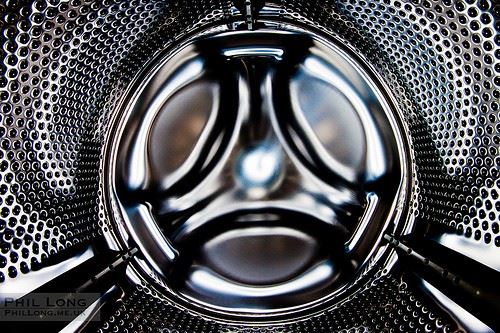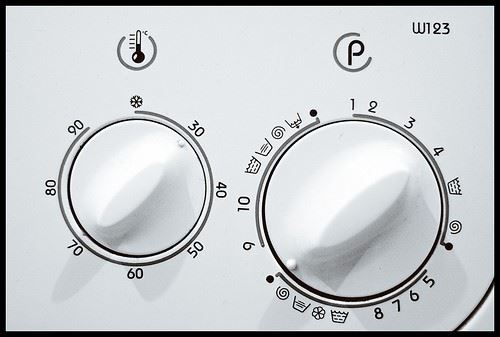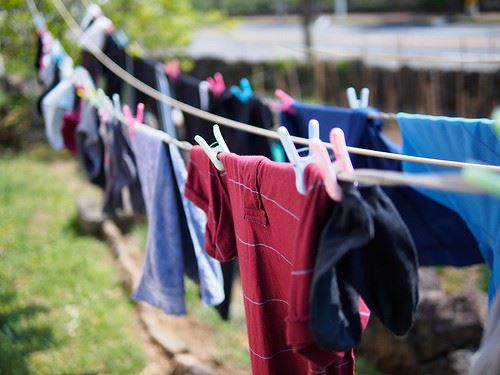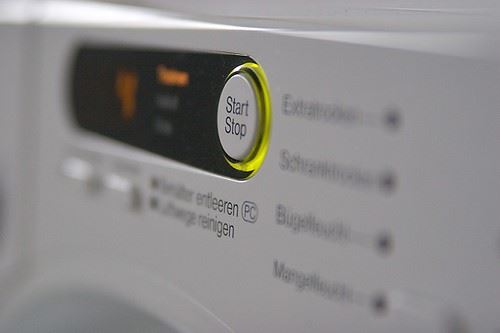Next Day Delivery Available
How to Save Money with Just Your Washing Machine

Image by Phil Long
The washing machine is a kitchen’s very own spinning miracle, a bastion of the modern home and the ultimate weekly purveyor of clean pants and socks.
Nevertheless, these imposing steel saviours account for around 7% of your energy bill, so it’s a good idea to embrace ways to use it in a more economical and cash-savvy fashion.
Here are a few simple but effective changes you can incorporate into the way you use your washing machine – keeping the costs down and you quids in.
Low Water Levels
Wash your laundry on the lowest water level and the shortest cycle possible to cut back on the amount of water you use (and waste).
Keep It Cool
When possible, use a 30 degree or cold water cycle. Hotter temperatures are only really necessary for ground-in stains or particularly dirty clothes.
Pre-scrub Stubborn Stains
Before you pop your laundry in the washing machine, rub shirt collars and soak heavily soiled items, as this will reduce the chance of having to wash them again because a few stubborn stains didn’t come out.
Fill Up with a Full Load
Cut back on unnecessary water-wasting, time-consuming, money-burning small washes by filling the drum with a full load of laundry. If you’ve run out of socks and boxers, fair enough, but it’s best to wait until your washing basket’s full before you pop on the rinse cycle.

Image by Paul Hudson
Clothing Essentials
Consider what type of clothes you usually buy. It may be that you do lots of washes for particular clothing because that’s what you like wearing – in which case, it might be a good idea to expand your wardrobe with some additional, similar items.
Throw in the Towel
Bath towels are typically made of heavyweight cotton and particularly large, so think about investing in smaller, standard lightweight towels to save energy.
Need for Speed
Use a high-spin speed whenever you can, so your clothes come out of the washing machine practically dry, with only the minimum need for tumble drying. Of course, when it comes to drying clothes the most cost-effective way is to use a washing line.
Hot and Cold Mix
If you mainly do low temperature washes, try to include a few occasional hot washes as this will prevent the build-up of unpleasant odours and get rid of any bacteria.

Image by Kim MyoungSung
Warm and Dry
Of course, after you’ve washed your laundry you’ll need to dry it. If you can’t hang it on the line outside then you’ll need to use a tumble dryer.
Although the majority of them meet the energy-efficient standards of EC A-G labels and improved technology, here are few pointers for drying your clothes with the minimum of energy usage and expenditure.
- Dry similar fabrics together
- Clean the filters after you’ve used the tumble dryer to remove fluff build-up and keep it maintained
- Use auto-dry rather than a timed cycle so you don’t use unnecessary power
- Dry clothes only when you need to
- Don’t add damp items half way through the drying cycle
- Plan your washing you dry all washed clothes in the same load so you fill the dryer as much as possible
- Fill the dyer as much as possible to limit the times you use it – any subsequent loads will benefit from the machine’s built-up heat
- Take out the clothes as soon as they’re dry – some machines carry on rotating to minimise creasing and use more energy
- Check any vents are in good working order and clean them out if they’re filled with any debris, dust or fluff

Image by vIZZZual.com
At Ransom Spares we have a fantastic selection of washing machine spares and parts and tumble dryer spares and parts. You can also watch our DIY repair videos for washing machines and tumble dryers.
By Lee Gilbert
Category: Articles, News & Tips






 By Lee Gilbert
By Lee Gilbert On 17th Nov 2014 at 08:27
On 17th Nov 2014 at 08:27

No Comments